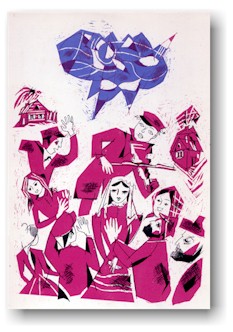
Klezmer (klez´mær) n. 1 pl. klez´mor·im´ (-mæ reem´) a) [Historical] an itinerant musician who performed at Jewish weddings and holiday celebrations in Eastern Europe b) a musician who performs instrumental Jewish folk music derived from Eastern European folk songs, Hebrew melodies, etc. 2 this instrumental folk music
from Webster's NewWorld Dictionary
When my non-Jewish friends ask me what is Klezmer, my typical answer is always, "You know - the music from Fiddler on the Roof. Beyond that, I had never really thought about it - Klezmer music and Klezmer bands just seemed like an obvious part of my experience of being Jewish, like lighting the Shabbos candles or going to a Bar Mitzvah. I didn't have much knowledge of the origins of Klezmer, and the dictionary definition (above) didn't satisfy me, so for this page I did a bit of research.
The Yiddish word Klezmer is derived from the Hebrew words, klay (instrument) and zemer (music). So, obviously, the literal meaning of Klezmer is "instrument of song". It has its roots centuries ago in the shtetlach (Jewish villages) of Eastern Europe, where it was originally meant to imitate the voice/music of the chazzan (cantor) in the synagogue. The first Klezmer tunes were in fact based on the chanted Hebrew melodies of the Jewish service. Klezmer played an integral part in the culture and celebrations of Eastern European Jewry. Some of the "traditional" instruments in the bands were clarinet, violin, flute and accordion.
When the Jews of Eastern Europe began immigrating to North America, they brought Klezmer music with them. However, with immigration came the desire of many Jews to abandon their Jewish culture and "ghetto mentality", and become "real Americans". As a result, Klezmer music came to be seen as an embarrassment, and for a time was not very popular among the general Jewish community.
Thankfully, over the past 30 years or so, Klezmer music is enjoying a remarkable comeback. There are now traditional and non-traditional Klezmer Bands in all corners of the world, and once again Klezmer is popular in Jewish celebrations, as well as non-Jewish ones. The non-traditional Klezmer music of present day is influenced not only by its Eastern European roots, gypsy melodies and balkan music, but also by Israeli horas, jazz, and the folk music of other lands. It includes a large variety of musical instruments, and many bands also feature vocals.